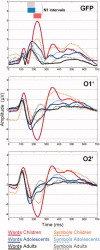Tuning of the visual word processing system: distinct developmental ERP and fMRI effects
- PMID: 19288464
- PMCID: PMC6871060
- DOI: 10.1002/hbm.20751
Tuning of the visual word processing system: distinct developmental ERP and fMRI effects
Abstract
Visual tuning for words vs. symbol strings yields complementary increases of fast occipito-temporal activity (N1 or N170) in the event-related potential (ERP), and posterior-anterior gradients of increasing word-specific activity with functional magnetic resonance imaging (fMRI) in the visual word form system (VWFS). However, correlation of these coarse ERP and fMRI tuning responses seems limited to the most anterior part of the VWFS in adult and adolescent readers (Brem et al. [ 2006]: Neuroimage 29:822-837). We thus focused on fMRI tuning gradients of young readers with their more pronounced ERP print tuning, and compared developmental aspects of ERP and fMRI response tuning in the VWFS. Children (10.3 y, n = 19), adolescents (16.2 y, n = 13) and adults (25.2 y, n = 18) were tested with the same implicit reading paradigm using counterbalanced ERP and fMRI imaging. The word-specific occipito-temporal N1 specialization, its corresponding source activity, as well as the integrated source activity (0-700 ms) were most prominent in children and showed a marked decrease with age. The posterior-anterior fMRI gradient of word-specific activity instead which was fully established in children did not develop further, but exhibited a dependence on reading skills independent of age. To conclude, prominent developmental dissociation of the ERP and fMRI tuning patterns emerged despite convergent VWFS localization. The ERP response may selectively reflect fast visual aspects of print specialization, which become less important with age, while the fMRI response seems dominated by integrated task- and reading-related activations in the same regions.
Visual tuning for words vs. symbol strings yields complementary increases of fast occipito‐temporal activity (N1 or N170) in the event‐related potential (ERP), and posterior–anterior gradients of increasing word‐specific activity with functional magnetic resonance imaging (fMRI) in the visual word form system (VWFS). However, correlation of these coarse ERP and fMRI tuning responses seems limited to the most anterior part of the VWFS in adult and adolescent readers (Brem et al. [ 2006]: Neuroimage 29:822–837). We thus focused on fMRI tuning gradients of young readers with their more pronounced ERP print tuning, and compared developmental aspects of ERP and fMRI response tuning in the VWFS. Children (10.3 y, n = 19), adolescents (16.2 y, n = 13) and adults (25.2 y, n = 18) were tested with the same implicit reading paradigm using counterbalanced ERP and fMRI imaging. The word‐specific occipito‐temporal N1 specialization, its corresponding source activity, as well as the integrated source activity (0–700 ms) were most prominent in children and showed a marked decrease with age. The posterior–anterior fMRI gradient of word‐specific activity instead which was fully established in children did not develop further, but exhibited a dependence on reading skills independent of age. To conclude, prominent developmental dissociation of the ERP and fMRI tuning patterns emerged despite convergent VWFS localization. The ERP response may selectively reflect fast visual aspects of print specialization, which become less important with age, while the fMRI response seems dominated by integrated task‐ and reading‐related activations in the same regions. Hum Brain Mapp, 2009. © 2009 Wiley‐Liss, Inc.
(c) 2009 Wiley-Liss, Inc.
Figures





References
-
- Allison T,McCarthy G,Nobre A,Puce A,Belger A ( 1994): Human extrastriate visual cortex and the perception of faces, words, numbers, and colors. Cereb Cortex 4: 544–554. - PubMed
-
- Bentin S,Mouchetant‐Rostaing Y,Giard MH,Echallier JF,Pernier J ( 1999): ERP manifestations of processing printed words at different psycholinguistic levels: Time course and scalp distribution. J Cogn Neurosci 11: 235–260. - PubMed
-
- Booth JR,Burman DD,Van Santen FW,Harasaki Y,Gitelman DR,Parrish TB,Marsel Mesulam MM ( 2001): The development of specialized brain systems in reading and oral‐language. Neuropsychol Dev Cogn C Child Neuropsychol 7: 119–141. - PubMed
-
- Brem S,Bucher K,Halder P,Summers P,Dietrich T,Martin E,Brandeis D ( 2006): Evidence for developmental changes in the visual word processing network beyond adolescence. Neuroimage 29: 822–837. - PubMed
-
- Brett M, Anton J‐L, Valabregue R, Poline J‐B ( 2002): Region of interest analysis using an SPM toolbox [abstract]. Presented at the 8th International Conference on Functional Mapping of the Human Brain, Sendai, Japan.
MeSH terms
LinkOut - more resources
Full Text Sources

